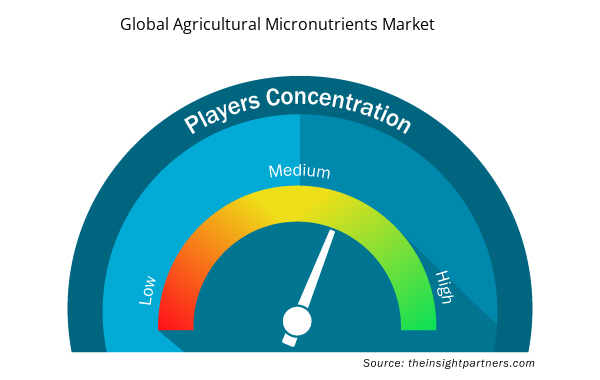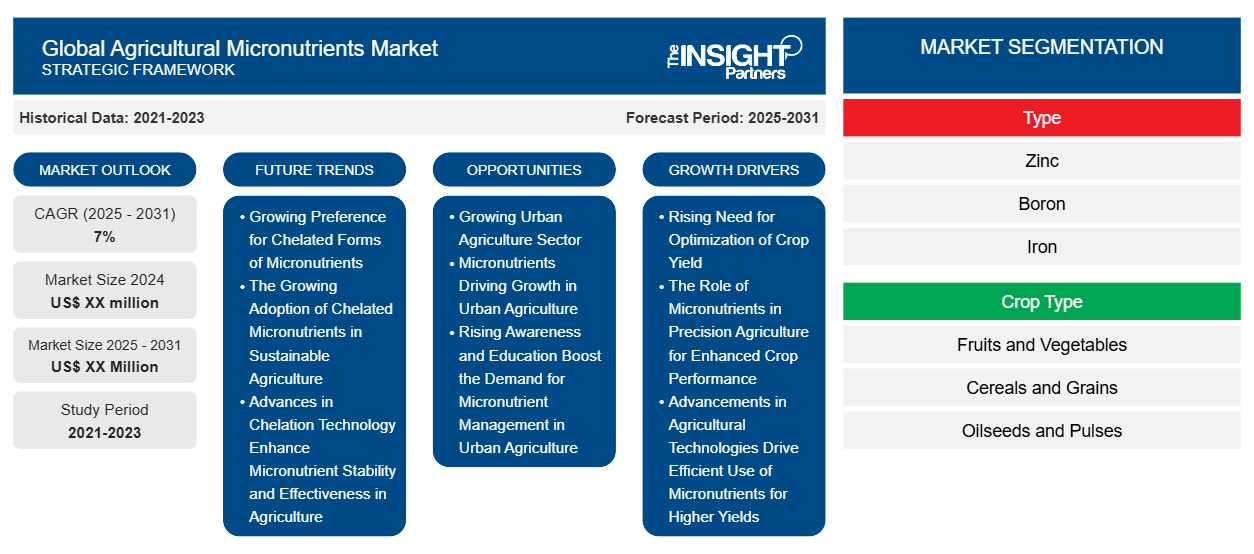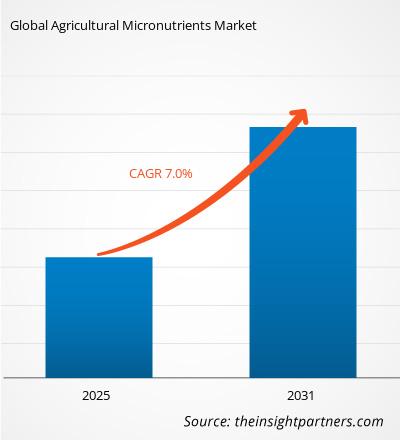農業微量栄養素市場は、2023年から2031年にかけて7%のCAGRを記録し、市場規模は2023年のXX百万米ドルから2031年にはXX百万米ドルに拡大すると予想されています。
レポートは、タイプ(亜鉛、ホウ素、鉄、モリブデン、銅、マンガン、その他)別にセグメント化されています。レポートではさらに、作物タイプ(果物と野菜、穀類と穀物、油糧種子と豆類、その他)に基づく分析を提示しています。フォームに基づいて、レポートは(キレート化と非キレート化)に分割されています。適用モードに基づいて、レポートは(土壌、葉面散布、施肥、その他)に分割されています。グローバル分析は、地域レベルと主要国でさらに細分化されています。レポートは、上記の分析とセグメントに対してUSDでの値を提供します。
報告書の目的
The Insight Partners による農業微量栄養素市場レポートは、現在の状況と将来の成長、主な推進要因、課題、機会を説明することを目的としています。これにより、次のようなさまざまなビジネス関係者に洞察が提供されます。
- テクノロジープロバイダー/メーカー: 進化する市場の動向を理解し、潜在的な成長機会を把握することで、情報に基づいた戦略的意思決定が可能になります。
- 投資家: 市場の成長率、市場の財務予測、バリュー チェーン全体に存在する機会に関する包括的な傾向分析を実施します。
- 規制機関: 市場の濫用を最小限に抑え、投資家の信用と信頼を維持し、市場の完全性と安定性を維持することを目的として、市場における政策と警察活動を規制します。
農業微量栄養素市場のセグメンテーション
タイプ
- 亜鉛
- ボロン
- 鉄
- モリブデン
- 銅
- マンガン
作物の種類
- 果物と野菜
- 穀物
- 油糧種子および豆類
形状
- キレート化と非キレート化
地理
- 北米
- ヨーロッパ
- アジア太平洋
- 南米と中央アメリカ
- 中東およびアフリカ
地理
- 北米
- ヨーロッパ
- アジア太平洋
- 南米と中央アメリカ
- 中東およびアフリカ
要件に合わせてレポートをカスタマイズする
このレポートの一部、国レベルの分析、Excelデータパックなど、あらゆるレポートを無料でカスタマイズできます。また、スタートアップや大学向けのお得なオファーや割引もご利用いただけます。
- このレポートの主要な市場動向を入手してください。この無料サンプルには、市場動向から見積もりや予測に至るまでのデータ分析が含まれます。
農業微量栄養素市場の成長要因
- 作物収量の最適化の必要性の高まり: 農業微量栄養素市場にもたらされる大きな影響の 1 つは、収量の最適化の増加です。これは、農家が作物の生産性と品質を高めようとする傾向から生じ、亜鉛、鉄、マンガンなどの微量栄養素の需要が高まります。これは、特に環境条件が悪い場合、植物の健康と収量の重要な要素の 1 つです。
- 作物の生産性向上のための精密農業における微量栄養素の役割: 人口の急速な増加に伴い、食料不安とともに農業生産量の最適化が求められています。作物の生産性を制限する要素の欠乏を補うために、農家はますます肥料や土壌改良剤を畑に持ち込んでいます。精密農業への注目により、持続可能な農業の実践における微量栄養素の役割に対する認識がさらに高まります。
- 農業技術の進歩により微量栄養素の効率的な使用が促進され、収穫量が増加します。同様に、微量栄養素の大量使用も農業技術によって促進されます。土壌検査と栄養管理のシステムが改善されたことにより、農家は一般的に、より慎重に投入量を増やすことができ、収穫量の増加だけでなく、資源の経済的な使用によって農場運営の収益性を高めることができます。
農業微量栄養素市場の将来動向
- キレート化された微量栄養素に対する好感度の高まり: 農業用微量栄養素の新たな傾向の 1 つは、キレート化された微量栄養素に対する需要の増加です。キレート化された微量栄養素は、有機分子にキレート化された微量栄養素であり、従来の形態よりも生物学的利用能が高く、そのため植物による吸収率が高くなり、作物の生育が向上します。
- 持続可能な農業におけるキレート化微量栄養素の採用の増加: 農家の発見によって報告されたキレート化微量栄養素の適用のもう 1 つの利点は、土壌の特定の栄養素欠乏をターゲットに修正することです。栄養素管理に対する環境意識の高まりが増すにつれて、これらの形態は、植物の健康と収穫量を向上させる方法として、ますます多くの農家に容易に採用されています。この傾向は、持続可能な農業を採用するようにという世界中のすべての国への呼びかけと一致しています。
- キレート化技術の進歩により、農業における微量栄養素の安定性と有効性が向上: 他の要因によるキレート化技術の進歩。キレート化微量栄養素の配合方法をさらに改善することで、安定性と有効性が向上します。キレート化微量栄養素のこのような新しい配合により、適用しやすくなり、より良い結果が得られます。これは、農業部門内でのより広範かつ体系的な導入を促す例です。
農業微量栄養素市場の機会
- 成長する都市農業セクター: 実際、成長する都市農業セクターは、農業微量栄養素市場にとって非常に大きな成長源です。食料需要を満たすための不可欠な方法として都市内での食料生産への依存が進むにつれて、栄養管理はますます重要になっています。微量栄養素は、これらのコンパクトな農業システムの生産性を高める上で重要な役割を果たします。
- 微量栄養素が都市農業の成長を牽引: この分野での新しいアイデアは垂直農法と水耕栽培です。これらは、正確に配合された栄養素がなければ機能しません。都市農業などの管理された環境で植物の成長を最大限に高めるのは微量栄養素です。都市農家はこれらの微量栄養素を使用して、狭苦しいスペースでより高い収穫量を実現します。これらの微量栄養素製品は、都市農業環境での使用がますます求められています。
- 意識と教育の高まりが都市農業における微量栄養素管理の需要を押し上げる: 都市における教育プログラムとトレーニングに関する一般の意識が高まると、栄養管理の意識に対する需要も高まります。都市農業における微量栄養素の利点に対する意識が高まると、そのような製品の傾向がさらに高まります。したがって、都市農業の傾向が拡大し続けるにつれて、農業微量栄養素市場は成長し続けるでしょう。
世界の農業微量栄養素市場の地域別洞察
予測期間を通じて世界の農業微量栄養素市場に影響を与える地域的な傾向と要因は、Insight Partners のアナリストによって徹底的に説明されています。このセクションでは、北米、ヨーロッパ、アジア太平洋、中東、アフリカ、南米、中米にわたる世界の農業微量栄養素市場のセグメントと地理についても説明します。

- 世界の農業微量栄養素市場の地域別データを入手
世界の農業微量栄養素市場レポートの範囲
| レポート属性 | 詳細 |
|---|---|
| 2023年の市場規模 | XX百万米ドル |
| 2031年までの市場規模 | XX百万米ドル |
| 世界のCAGR(2023年~2031年) | 7% |
| 履歴データ | 2021-2022 |
| 予測期間 | 2024-2031 |
| 対象セグメント | タイプ別
|
| 対象地域と国 | 北米
|
| 市場リーダーと主要企業プロフィール |
|
世界の農業微量栄養素市場のプレーヤー密度:ビジネスダイナミクスへの影響を理解する
世界の農業微量栄養素市場は、消費者の嗜好の変化、技術の進歩、製品の利点に対する認識の高まりなどの要因により、エンドユーザーの需要が高まり、急速に成長しています。需要が高まるにつれて、企業は提供を拡大し、消費者のニーズを満たすために革新し、新たなトレンドを活用し、市場の成長をさらに促進しています。
市場プレーヤー密度とは、特定の市場または業界内で活動している企業または会社の分布を指します。これは、特定の市場スペースに、その市場規模または総市場価値に対してどれだけの競合相手 (市場プレーヤー) が存在するかを示します。
世界の農業微量栄養素市場で事業を展開している主要企業は次のとおりです。
- BASF SE
- コロマンデルインターナショナルリミテッド
- ニュートリエン株式会社
- モザイクカンパニー
- ハイファグループ
免責事項:上記の企業は、特定の順序でランク付けされていません。

- 世界の農業微量栄養素市場のトップキープレーヤーの概要を入手
主なセールスポイント
- 包括的なカバレッジ: レポートでは、農業微量栄養素市場の製品、サービス、タイプ、エンドユーザーの分析を包括的にカバーし、全体的な展望を提供します。
- 専門家による分析: レポートは、業界の専門家とアナリストの深い理解に基づいてまとめられています。
- 最新情報: このレポートは、最新の情報とデータの傾向を網羅しているため、ビジネスの関連性を保証します。
- カスタマイズ オプション: このレポートは、特定のクライアント要件に対応し、ビジネス戦略に適切に適合するようにカスタマイズできます。
したがって、農業微量栄養素市場に関する調査レポートは、業界のシナリオと成長の見通しを解読し理解する道の先導役となることができます。正当な懸念事項がいくつかあるかもしれませんが、このレポートの全体的な利点は欠点を上回る傾向があります。
- 過去2年間の分析、基準年、CAGRによる予測(7年間)
- PEST分析とSWOT分析
- 市場規模価値/数量 - 世界、地域、国
- 業界と競争環境
- Excel データセット



Report Coverage
Revenue forecast, Company Analysis, Industry landscape, Growth factors, and Trends

Segment Covered
This text is related
to segments covered.

Regional Scope
North America, Europe, Asia Pacific, Middle East & Africa, South & Central America

Country Scope
This text is related
to country scope.
よくある質問
Growing Preference for Chelated Forms of Micronutrients is expected to be the key market trends.
Based on geography, Asia Pacific held the largest share of the agricultural micronutrients market.
Based on type, zinc, is expected to witness the fastest growth during the forecast period
BASF SE, Coromandel International Limited, Nutrien Ltd are some of the key players operating in the agricultural micronutrients market
Rising Need for Optimization of Crop Yield is driving the market growth
The Agricultural Micronutrients Market is estimated to witness a CAGR of 7% from 2023 to 2031
Trends and growth analysis reports related to Chemicals and Materials : READ MORE..
The List of Companies
1. BASF SE
2. Coromandel International Limited
3. Nutrien Ltd.
4. The Mosaic Company
5. Haifa Group
6. Yara International ASA
7. Helena Agri-Enterprises LLC
8. Valagro S.p.A
9. Sigma AgriScience, LLC
10. Aries Agro Limited
11. Nufarm Limited
12. AgroLiquid
13. Agrium
14. Akzonobel
15. Dow Chemical
16. ADAMA Agricultural Solutions Ltd.
17. Agrium Inc.
18. Akzo Nobel N.V.
19. Auriga Industries A/S
20.Bayer Crop.
The Insight Partners performs research in 4 major stages: Data Collection & Secondary Research, Primary Research, Data Analysis and Data Triangulation & Final Review.
- Data Collection and Secondary Research:
As a market research and consulting firm operating from a decade, we have published and advised several client across the globe. First step for any study will start with an assessment of currently available data and insights from existing reports. Further, historical and current market information is collected from Investor Presentations, Annual Reports, SEC Filings, etc., and other information related to company’s performance and market positioning are gathered from Paid Databases (Factiva, Hoovers, and Reuters) and various other publications available in public domain.
Several associations trade associates, technical forums, institutes, societies and organization are accessed to gain technical as well as market related insights through their publications such as research papers, blogs and press releases related to the studies are referred to get cues about the market. Further, white papers, journals, magazines, and other news articles published in last 3 years are scrutinized and analyzed to understand the current market trends.
- Primary Research:
The primarily interview analysis comprise of data obtained from industry participants interview and answers to survey questions gathered by in-house primary team.
For primary research, interviews are conducted with industry experts/CEOs/Marketing Managers/VPs/Subject Matter Experts from both demand and supply side to get a 360-degree view of the market. The primary team conducts several interviews based on the complexity of the markets to understand the various market trends and dynamics which makes research more credible and precise.
A typical research interview fulfils the following functions:
- Provides first-hand information on the market size, market trends, growth trends, competitive landscape, and outlook
- Validates and strengthens in-house secondary research findings
- Develops the analysis team’s expertise and market understanding
Primary research involves email interactions and telephone interviews for each market, category, segment, and sub-segment across geographies. The participants who typically take part in such a process include, but are not limited to:
- Industry participants: VPs, business development managers, market intelligence managers and national sales managers
- Outside experts: Valuation experts, research analysts and key opinion leaders specializing in the electronics and semiconductor industry.
Below is the breakup of our primary respondents by company, designation, and region:

Once we receive the confirmation from primary research sources or primary respondents, we finalize the base year market estimation and forecast the data as per the macroeconomic and microeconomic factors assessed during data collection.
- Data Analysis:
Once data is validated through both secondary as well as primary respondents, we finalize the market estimations by hypothesis formulation and factor analysis at regional and country level.
- Macro-Economic Factor Analysis:
We analyse macroeconomic indicators such the gross domestic product (GDP), increase in the demand for goods and services across industries, technological advancement, regional economic growth, governmental policies, the influence of COVID-19, PEST analysis, and other aspects. This analysis aids in setting benchmarks for various nations/regions and approximating market splits. Additionally, the general trend of the aforementioned components aid in determining the market's development possibilities.
- Country Level Data:
Various factors that are especially aligned to the country are taken into account to determine the market size for a certain area and country, including the presence of vendors, such as headquarters and offices, the country's GDP, demand patterns, and industry growth. To comprehend the market dynamics for the nation, a number of growth variables, inhibitors, application areas, and current market trends are researched. The aforementioned elements aid in determining the country's overall market's growth potential.
- Company Profile:
The “Table of Contents” is formulated by listing and analyzing more than 25 - 30 companies operating in the market ecosystem across geographies. However, we profile only 10 companies as a standard practice in our syndicate reports. These 10 companies comprise leading, emerging, and regional players. Nonetheless, our analysis is not restricted to the 10 listed companies, we also analyze other companies present in the market to develop a holistic view and understand the prevailing trends. The “Company Profiles” section in the report covers key facts, business description, products & services, financial information, SWOT analysis, and key developments. The financial information presented is extracted from the annual reports and official documents of the publicly listed companies. Upon collecting the information for the sections of respective companies, we verify them via various primary sources and then compile the data in respective company profiles. The company level information helps us in deriving the base number as well as in forecasting the market size.
- Developing Base Number:
Aggregation of sales statistics (2020-2022) and macro-economic factor, and other secondary and primary research insights are utilized to arrive at base number and related market shares for 2022. The data gaps are identified in this step and relevant market data is analyzed, collected from paid primary interviews or databases. On finalizing the base year market size, forecasts are developed on the basis of macro-economic, industry and market growth factors and company level analysis.
- Data Triangulation and Final Review:
The market findings and base year market size calculations are validated from supply as well as demand side. Demand side validations are based on macro-economic factor analysis and benchmarks for respective regions and countries. In case of supply side validations, revenues of major companies are estimated (in case not available) based on industry benchmark, approximate number of employees, product portfolio, and primary interviews revenues are gathered. Further revenue from target product/service segment is assessed to avoid overshooting of market statistics. In case of heavy deviations between supply and demand side values, all thes steps are repeated to achieve synchronization.
We follow an iterative model, wherein we share our research findings with Subject Matter Experts (SME’s) and Key Opinion Leaders (KOLs) until consensus view of the market is not formulated – this model negates any drastic deviation in the opinions of experts. Only validated and universally acceptable research findings are quoted in our reports.
We have important check points that we use to validate our research findings – which we call – data triangulation, where we validate the information, we generate from secondary sources with primary interviews and then we re-validate with our internal data bases and Subject matter experts. This comprehensive model enables us to deliver high quality, reliable data in shortest possible time.


 このレポートの無料サンプルを入手する
このレポートの無料サンプルを入手する